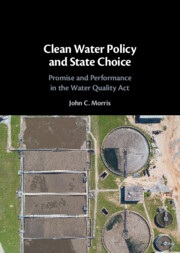Book contents
- Clean Water Policy and State Choice
- Clean Water Policy and State Choice
- Copyright page
- Dedication
- Epigraph
- Contents
- Figures
- Tables
- Foreword
- Acknowledgments
- Abbreviations
- Introduction
- 1 Setting the Stage
- 2 Reagan Federalism, States’ Rights, and the Revolving Loan Fund Model
- 3 The Foundations of Water Quality Policy in the United States
- 4 Expansion and Contraction in the Federal Role in Water Quality Policy
- 5 Features of the Water Quality Act of 1987
- 6 A Model of State Implementation of the Clean Water State Revolving Fund Program
- 7 Initial State Implementation of the Revolving Loan Fund Model
- 8 Implementation “On the Ground”
- 9 The Distributional Impacts of the CWSRF
- 10 Promise and Performance
- Book part
- About the Author
- Notes
- References
- Index
8 - Implementation “On the Ground”
Four Case Studies
Published online by Cambridge University Press: 10 March 2022
- Clean Water Policy and State Choice
- Clean Water Policy and State Choice
- Copyright page
- Dedication
- Epigraph
- Contents
- Figures
- Tables
- Foreword
- Acknowledgments
- Abbreviations
- Introduction
- 1 Setting the Stage
- 2 Reagan Federalism, States’ Rights, and the Revolving Loan Fund Model
- 3 The Foundations of Water Quality Policy in the United States
- 4 Expansion and Contraction in the Federal Role in Water Quality Policy
- 5 Features of the Water Quality Act of 1987
- 6 A Model of State Implementation of the Clean Water State Revolving Fund Program
- 7 Initial State Implementation of the Revolving Loan Fund Model
- 8 Implementation “On the Ground”
- 9 The Distributional Impacts of the CWSRF
- 10 Promise and Performance
- Book part
- About the Author
- Notes
- References
- Index
Summary
This chapter presents in-depth case studies of initial implementation of the Clean Water State Revolving Fund (CWSRF) program. The four states chosen- Alabama, California, Georgia, and New York- represent states that took very different approaches to initial implementation: Alabama represents a state with a highly leveraged program and significant private sector involvement; California is a state with large needs that did not leverage; Georgia is a state that did not leverage and implemented the program without private sector involvement; and New York had huge needs but was delayed in implementation. Data are drawn from state documents, survey data, and in-depth interviews conducted with state program administrators. The case studies highlight the unique circumstances present in each state, and how these circumstances shaped the implementation decisions and, ultimately, the nature of the program developed in the state.
Keywords
- Type
- Chapter
- Information
- Clean Water Policy and State ChoicePromise and Performance in the Water Quality Act, pp. 164 - 189Publisher: Cambridge University PressPrint publication year: 2022

